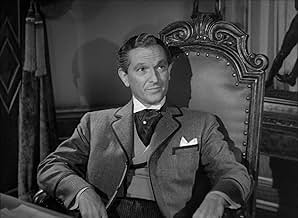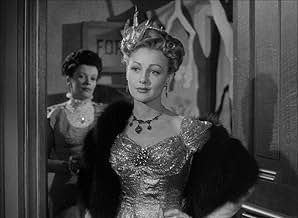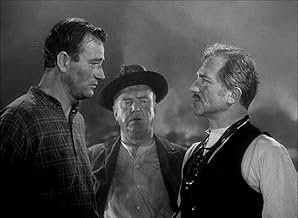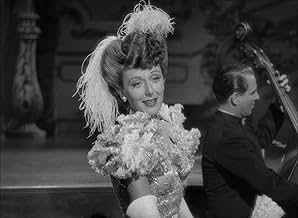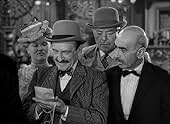IMDb RATING
6.2/10
1.7K
YOUR RATING
A cowboy competes with a gambling tycoon on the Barbary Coast for the hand of a beautiful dance-hall queen.A cowboy competes with a gambling tycoon on the Barbary Coast for the hand of a beautiful dance-hall queen.A cowboy competes with a gambling tycoon on the Barbary Coast for the hand of a beautiful dance-hall queen.
- Nominated for 2 Oscars
- 2 nominations total
Abdullah Abbas
- Saloon Patron
- (uncredited)
Eddie Acuff
- Fireman
- (uncredited)
Doc Adams
- Saloon Patron
- (uncredited)
- Director
- Writers
- All cast & crew
- Production, box office & more at IMDbPro
Featured reviews
Who ever came up with the title is to be commended. It suggests a storyline way, way, more interesting than this film turns out to actually be! "Tito" (Joseph Schildkraut) pretty much runs San Francisco and together with his gal "Flaxen" (Ann Dvorak) has quite a easy life - until, that is, cowboy "Duke" (John Wayne) arrives in town and takes a bit of a shine to the lady. He's just a touch too naive though for city life, and soon has to head home - broke - after being fleeced in the casino. Determined to win it all back - and more - he takes lessons in card-playing and soon returns, this time much better prepared to combat the dodgy goings-on at the card table, and to win the heart of the lady. Sadly, aside from a rare few scenes of fisticuff action, this is all rather dreary. The scenario is well trodden, and although Dvorak makes for quite a decent leading lady, the rivalry between the sophisticate crook and his handsome interloper just doesn't ever catch fire. The pace is just too forced, and there is far too much emphasis on the rather uninteresting love triangle element. This film is only really notable for the last fifteen minutes which offers us quite a well created and impressive look at just how the earthquake and subsequent fire devastated the city leaving carnage - and opportunity - in it's wake. Again there is plenty of charm from the star, but it is nowhere near enough to sustain this and though it might have been more impressive on a big screen, on a small one it proves merely to be quite a procedural and, frankly, dull, vehicle for Wayne that promises much but delivers little.
Happy-go-lucky Montana rancher John Wayne comes to San Francisco, wins and loses a fortune in a night, and begins a competition with a sleazy gambling-hall owner for the heart of singer Ann Dvorak. After some lessons from aging card-shark William Frawley, he comes back to town to win back the money and the girl.
Another of the Duke's lightweight, nineteen-forties Republic pictures, this okay romantic melodrama features a likable Wayne performance, some fairly lavish sets and costumes, and a neat low-budget recreation of the great San Francisco earthquake of 1906.
This isn't the greatest or most memorable of John Wayne vehicles, but it's not the worst either.
Another of the Duke's lightweight, nineteen-forties Republic pictures, this okay romantic melodrama features a likable Wayne performance, some fairly lavish sets and costumes, and a neat low-budget recreation of the great San Francisco earthquake of 1906.
This isn't the greatest or most memorable of John Wayne vehicles, but it's not the worst either.
John Wayne stars as Montana cattle rancher Duke Fergus. He heads to San Francisco to conduct some business and ends up losing his shirt at the Barbary Coast gambling dens, particularly that of Tito Morell (Joseph Schildkraut). Duke vows to master the gambling arts and return to Frisco, not just for revenge, but to win the hand of Morell's showgirl moll Flaxen Tarry (Ann Dvorak). This being turn-of-the-century San Francisco, you just know that the Great Earthquake is going interrupt everyone's plans.
This was another of Republic's "A" pictures, with time spent on costumes, sets, and expensive set-pieces (such as the earthquake sequence, or a large cattle drive). The movie isn't terrible, but the script is bit weak, like in most of these Republic showcases. There's never a good rhythm established to the narrative, and the three main characters never rise above sketches. Dvorak looks good, but if that's her real singing voice heard on the soundtrack, it's pretty awful. Still, if one likes SF earthquake melodrama and adventure, this may be worth checking out. It earned two Oscar nominations, for Best Sound, and Best Score.
This was another of Republic's "A" pictures, with time spent on costumes, sets, and expensive set-pieces (such as the earthquake sequence, or a large cattle drive). The movie isn't terrible, but the script is bit weak, like in most of these Republic showcases. There's never a good rhythm established to the narrative, and the three main characters never rise above sketches. Dvorak looks good, but if that's her real singing voice heard on the soundtrack, it's pretty awful. Still, if one likes SF earthquake melodrama and adventure, this may be worth checking out. It earned two Oscar nominations, for Best Sound, and Best Score.
Lesser John Wayne vehicle with Duke playing a character named...Duke. Set in early Twentieth Century San Francisco (a popular setting for many movies made during the classic Hollywood era), Duke plays a gambler who falls for a saloon singer (a miscast Ann Dvorak) and crosses swords with accented villain Joseph Schildkraut, who believes the lady belongs to him. Dvorak, about ten years past her prime (career-wise not looks; she was still lovely) was a poor fit for a sultry singer that turns men's heads. By contrast, Virginia Grey appears in a supporting role and seems a much better fit for the lead role. Dvorak also has remarkably little chemistry with John Wayne. Not to bag on her. She was a great actress, particularly in her pre-Code films where she had grittier roles than this. Schildkraut was a decent actor who certainly could make you hate him. But every film I've seen where Duke's opponent is a wimpy tycoon or bureaucrat or something always seems to suffer for it. The villain in a John Wayne movie needs to be intimidating. This guy just isn't. Creepy at best. For his part, Duke does fine. Not really his type of role as written on the page but he sort of makes it his. Worth a look for Wayne fans but it's not one of his best.
Before watching Flame Of Barbary Coast I never read the description on the back cover of the DVD case. It mentions the San Francisco earthquake of 1906. Fortunately I was aware of some of the history of that earthquake, so I was picking up the clues given throughout the movie. All I cared about before watching the movie was that it was a western with John Wayne in it. The movie is a "late" western in that it takes place as the wild west had been tamed and the 20th Century was becoming an entirely different reality.
The plot was okay, but a little thin. A Montana rancher goes to the big city, finds himself played out as a sucker, and returns to conquer the same people who made a fool out of him. Duke Fergus (John Wayne) takes lessons from his professional gambler friend, Wolf Wylie (William Frawley), and ends up beating the professional gamblers in their own casinos. Even for John Wayne this is quite amazing. Added to that is his love interest in Flaxen (Ann Dvorak), known as "the Flame of the Barbary Coast", who apparently has teased virtually every powerful man in town. At the time of the story she is tied to Tito Morrell (Joseph Schildkraut), the most successful and notorious of the gambling house bosses.
I liked the way Joseph Schildkraut played the classy, but devious, casino owner, Tito Morrell. His character hinted at aristocratic old world lineage and his determination to maintain a level of sophistication despite his present reputation. Tito's criminal side is never shown, only implied. John Wayne's character, Duke, never came across as simple. He loved his modest environment at his ranch in Montana, but he had a business sense and some integrity. Ann Dvorak's Flaxen is the character that seems a bit odd. If she has such a reputation for being the unobtainable prize, why do so many still want her? She really does smile her way through everything, too. It would have been really nice if she got one of those famous John Wayne spankings.
Establishing a specific time was done gradually and then deliberately. The house Tito provides for Flaxen is definitely built in an elaborate turn of the century European-influenced style that would not have existed thirty years earlier. Upon arriving in San Francisco there were many electric lights. A bathroom with running water is shown. Eventually a specific date in January of 1906 is mentioned, and later it is mentioned that April of the same year has arrived. Although everyone is moving on foot or in a horse drawn carriage, an automobile appears in one scene. The time placement was subtle in the beginning and made perfectly clear as it became more important to the plot.
I expected the climax of the movie to be the famous San Francisco earthquake. There really were explosions and gas fires from ruptured natural gas lines. Firefighters are shown in the movie running out of water because of broken water mains just as the real firefighters did. It is even mentioned that looters would be shot, as they really were. The catalyst that brought about changes in San Francisco set up the final scenes for the main characters. The true nature of everyone is shown in a final showdown between Duke, Tito, and Flaxen.
I liked Flame Of Barbary Coast. My only complaint is that the movie makes the Barbary Coast seem to be the most important part of San Francisco, and it is the only part of the city that is shown. The sets were elaborate and the actors were good. It cannot be called a gangster movie even though it has crime bosses. Over all it was more of a drama than a western, but it was worth watching.
The plot was okay, but a little thin. A Montana rancher goes to the big city, finds himself played out as a sucker, and returns to conquer the same people who made a fool out of him. Duke Fergus (John Wayne) takes lessons from his professional gambler friend, Wolf Wylie (William Frawley), and ends up beating the professional gamblers in their own casinos. Even for John Wayne this is quite amazing. Added to that is his love interest in Flaxen (Ann Dvorak), known as "the Flame of the Barbary Coast", who apparently has teased virtually every powerful man in town. At the time of the story she is tied to Tito Morrell (Joseph Schildkraut), the most successful and notorious of the gambling house bosses.
I liked the way Joseph Schildkraut played the classy, but devious, casino owner, Tito Morrell. His character hinted at aristocratic old world lineage and his determination to maintain a level of sophistication despite his present reputation. Tito's criminal side is never shown, only implied. John Wayne's character, Duke, never came across as simple. He loved his modest environment at his ranch in Montana, but he had a business sense and some integrity. Ann Dvorak's Flaxen is the character that seems a bit odd. If she has such a reputation for being the unobtainable prize, why do so many still want her? She really does smile her way through everything, too. It would have been really nice if she got one of those famous John Wayne spankings.
Establishing a specific time was done gradually and then deliberately. The house Tito provides for Flaxen is definitely built in an elaborate turn of the century European-influenced style that would not have existed thirty years earlier. Upon arriving in San Francisco there were many electric lights. A bathroom with running water is shown. Eventually a specific date in January of 1906 is mentioned, and later it is mentioned that April of the same year has arrived. Although everyone is moving on foot or in a horse drawn carriage, an automobile appears in one scene. The time placement was subtle in the beginning and made perfectly clear as it became more important to the plot.
I expected the climax of the movie to be the famous San Francisco earthquake. There really were explosions and gas fires from ruptured natural gas lines. Firefighters are shown in the movie running out of water because of broken water mains just as the real firefighters did. It is even mentioned that looters would be shot, as they really were. The catalyst that brought about changes in San Francisco set up the final scenes for the main characters. The true nature of everyone is shown in a final showdown between Duke, Tito, and Flaxen.
I liked Flame Of Barbary Coast. My only complaint is that the movie makes the Barbary Coast seem to be the most important part of San Francisco, and it is the only part of the city that is shown. The sets were elaborate and the actors were good. It cannot be called a gangster movie even though it has crime bosses. Over all it was more of a drama than a western, but it was worth watching.
Did you know
- TriviaWhile in her home, Ann Dvorak introduces herself to John Wayne: "My name is Ann" to which he replies "and I am Duke". Dvorak's character's name is also her real name. Wayne's character's name was also his real-life nickname.
- GoofsJames D. "Jim" Phelan was Mayor of San Francisco from 1897 until 1902, serving 3 terms. He did not run for Mayor after the 1906 earthquake, but served on the Committee of Fifty, set up by the Mayor, Eugene Schmitz.
- Quotes
'Smooth' Wylie: Now the first thing to learn about a deck of cards is how to handle 'em. They're a whole lot like women, usually when you pick one up, you wish you hadn't!
- Alternate versionsAlso available in a computer colorized version.
- ConnectionsEdited into The Green Fog (2017)
- SoundtracksBy the Light of the Silvery Moon
(uncredited)
Music by Gus Edwards
Lyrics by Edward Madden
Performed by Ann Dvorak and the chorus
- How long is Flame of Barbary Coast?Powered by Alexa
Details
Box office
- Budget
- $600,000 (estimated)
- Runtime1 hour 31 minutes
- Color
- Aspect ratio
- 1.37 : 1
Contribute to this page
Suggest an edit or add missing content

Top Gap
By what name was La belle de San Francisco (1945) officially released in India in English?
Answer
